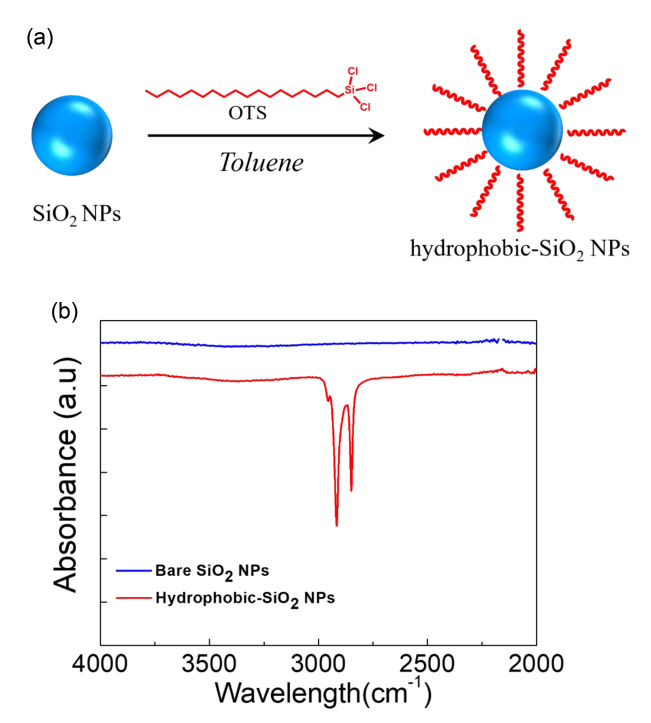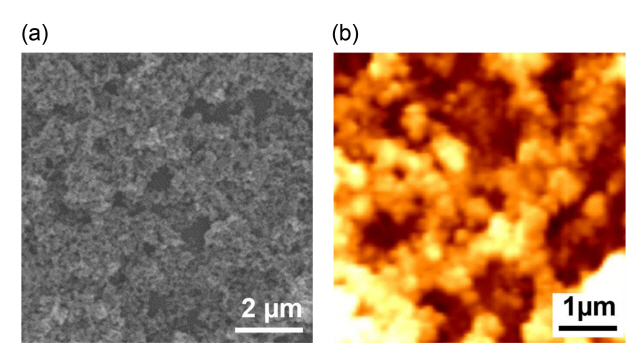1. INTRODUCTION
Nature-inspired superhydrophobic properties on surfaces with high water contact angles (WCAs; > 150o) have attracted considerable attention because of their various potential applications, including self-cleaning, antibacterial materials, anti-biofouling, and oil–water separation [1-7]. Previous researches have reported that superhydrophobic film surfaces can be produced with a combination of surface textures, with hierarchical roughness and low surface energy [8-13]. Generally, to achieve such hierarchical textured surfaces with low surface energies, multiple preparation steps are required, first to form a hierarchical structure, then additional hydrophobization using hydrocarbon-based molecules [14-16]. Typically, to attain high performance superhydrophobic properties, such as high WCAs, requires expensive fabrication processes and complicated procedures. Accordingly, previous approaches have been unsuitable for large-scale commercialization, because practical applications require inexpensive methods. In addition, facile approaches for producing robust superhydrophobic surfaces with high stability and self-healing abilities have rarely been reported. For high-throughput and large-area applications, a facile fabrication method is needed, to construct robust superhydrophobic films.
Herein, we present a rationally designed and simple fabrication method to produce self-healing and robust superhydrophobic hierarchical nanocomposite films via simple spray coating. The coating materials consisted of octadecyltrichlorosilane (OTS)-functionalized hydrophobic silica nanoparticles (hydrophobic-SiO2 NPs), to produce hierarchical surface textures with low surface energy, as well as 1,8-bis(triethoxysilyl)-octane (BTO) and octadecyltrimethoxysilane (OTMS), as cross-linking agents to generate strong polymeric networks to improve the stability between NPs in the composite film. The effect of the cross-linking agents to enhance the stability of superhydrophobic nanocomposite films was investigated by applying external influences, such as ultrasonication.
Using the optimized coating material composition to retain superhydrophobicity after ultrasonication, we further demonstrated the transparency and self-healing performance of the superhydrophobic nanocomposite films. The proposed solution-based spray coating method provides a simple route to construct transparent, robust, and self-healing superhydrophobic surfaces with high throughputs and large areas, which can be employed in various industrial applications, including conventional products and advanced non-wetting surfaces.
2. EXPERIMENTAL
Materials. The silica (SiO2) NPs (~20 nm, Sky Spring Nanomaterials), OTS (>90%, Aldrich), OTMS (90%, Aldrich), and BTO (98%, TCI) were used as received. All chemical solvents were purchased from Aldrich Chemical Co. and used without further purification.
Surface functionalization of the SiO2 NPs with OTMS. Before the self-assembly of OTMS, the NPs were dispersed in toluene (0.5 wt%, 5 mL) via ultrasonication for 30 min. Then, 1 mM OTMS (in toluene, 1 mL) was added to the pre-dispersed SiO2 NP solution. The mixture was ultrasonicated for 10 min and then allowed to react at room temperature for at least 2 h. After the reaction was completed, the OTS-functionalized hydrophobic SiO2 NPs (hydrophobic-SiO2) were separated by centrifugation and repeatedly rinsed with copious amounts of toluene and ethanol to remove unreacted excess OTMS. After washing, the functionalized hydrophobic-SiO2 NPs were vacuum-dried overnight. Fourier-transform infrared (FTIR) spectra of the functionalized hydrophobic-SiO2 NPs were acquired using a Nicolet 5700 spectrometer (Thermo Scientific).
Fabrication of the superhydrophobic nanocomposite films. To initiate the facile fabrication of self-healing robust and superhydrophobic nanocomposite films via spray coating and subsequent UV curing, a solution for spray coating was prepared as follows: Functionalized hydrophobic-SiO2 NPs (0.5 wt%) were ultrasonicated in isopropyl alcohol for 2 h. A mixture of cross-linking reagents (0.5 wt% of BTO and OTMS) was added to the dispersed hydrophobic-SiO2 NPs solution, and dispersed by sonication for 30 min. As a control, a coating solution containing only functionalized hydrophobic-SiO2 NPs without crosslinking agents was prepared to fabricate control nanocomposite films. Before film coating, the silicon wafer was cleaned by UV/ozone (UVO) cleaning for 5 min. Then, the coating solutions were sprayed over the Si wafers using an air sprayer (Sparmax Co., Ltd.) to obtain the superhydrophobic nanocomposite films, followed by annealing at 200°C for 1 h to accelerate the cross-linking reaction.
WCA and morphological characterization of the hydrophobic-SiO2 nanocomposite films. The surface energy properties of the films were characterized using contact angle measurement equipment (SEO Co, Phoenix-I). The WCAs of the nanocomposite films were determined via the sessile drop approach using deionized water. The surface morphology of the superhydrophobic nanocomposite films was observed using field-emission scanning electron microscopy (FESEM, Hitachi S4800) and atomic force microscopy (AFM, PSIA XE-150).
Stability test. The stability of the crosslinked nanocomposite films was characterized by determining the water contact angles of the composite films after sonication in ethanol at different time points. To examine their self-healing property, the optimized superhydrophobic films were exposed to UVO for 2 min. The damaged films were then stored in a vacuum oven at 110°C for recovery. The damage/healing cycles were repeated five times. Optical transmittance was obtained using a Cary 500 UV–visible spectrophotometer.
3. RESULTS AND DISCUSSION
Fig 1a shows a schematic illustration of the functionalization of hydrophobic-SiO2 NPs. In essence, trichlorosilane-based SAMs can be easily assembled on a silicon oxide surface through self-condensation between the alkoxyl group of the OTS and the hydroxyl functional groups on the surfaces of the SiO2 NPs [17]. After the reaction between OTS and silica nanoparticles, hydrophilic SiO2 NPs become hydrophobic due to the hydrocarbon terminal group of OTS.
To confirm the functionalization of hydrocarbon-based OTS on the silica NP surface, the hydrophobic-SiO2 NPs were analyzed using FTIR spectroscopy. The FTIR spectra of the functionalized hydrophobic-SiO2 NPs clearly demonstrated the presence of the OTS molecule, with absorbance peaks corresponding to the vibration mode of the methyl (–CH3) and methylene (–CH2–) groups (Fig 1b) [18]. The unfunctionalized pristine SiO2 NPs exhibited an almost featureless FTIR spectrum in the range of 1500–4000 cm−1, while the FTIR spectrum of the functionalized hydrophobic-SiO2 NPs showed the presence of two peaks at 2856 and 2929 cm−1, which originated from the vibration of the methylene groups of the OTMS, and a small shoulder peak at 2970 cm−1, corresponding to the methyl groups at the tail of OTS. Additionally, a less intense peak at 1453 cm−1 could be attributed to methylene scissoring vibrations [19].
Fig 2 illustrates the fabrication process of the self-healing, robust, and superhydrophobic nanocomposite films using functionalized hydrophobic-SiO2 NPs. The facile fabrication of the superhydrophobic film surfaces was achieved using rationally designed coating components that combined both hydrophobic roughness texture and thermal cross-linking reactions. For the spray coating solution components, we utilized (i) functionalized hydrophobic-SiO2 NPs to produce hierarchical roughness structures with low surface energy, as well as (ii) BTO and OTMS to obtain thermally crosslinked polymeric nanocomposite films.
Generally, superhydrophobicity can be achieved by combining hierarchical roughness structures and hydrophobic chemical compositions [20-23]. The nanocomposite films fabricated from the prepared coating solution containing hydrophobic-SiO2 NPs exhibited a superhydrophobic surface, due to the formation of a micro/nano dual-scale hierarchical structure. After fabricating the simple spray-coated films and thermal annealing, polymeric networks were formed by the cross-linking of BTO and OTMS via condensation between alkoxy functional groups. These strong covalent bonding networks improve the stability of the superhydrophobic films.
To understand the role of the cross-linking agents in the prepared films, we examined the influence of BTO and OTMS on the stability of the nanocomposite films by determining the WCA of the film without cross-linking agents as a function of ultrasonication time. Fig 3a shows the wettability of two different superhydrophobic nanocomposite films (with and without crosslinkers) under different sonication times ranging from 0 to 50 s. The ultrasonication test revealed that the UV-crosslinked nanocomposite films with both BTO and OTMS retained higher WCAs after the application of an external force (ultrasonication). For example, the WCAs of the nanocomposite films prepared without cross-linking agents (red line) decreased with increasing sonication time, and completely lost their initial superhydrophobicity after only 15 s of ultrasonication. In contrast, the thermally crosslinked nanocomposite films (black line) prepared using the coating solution containing both cross-linking agents exhibited higher WCAs (> 150°) even after 50 s of ultrasonication (Fig 3b) thanks to the cross-linked covalent bonding between the hydrophobic NPs in the films. Under continuous ultrasonication for 30 s, the thermally crosslinked nanocomposite film retained its superhydrophobicity with a high WCA of 152°. The AFM and FE-SEM images also support the stability of the crosslinked nanocomposite films. As shown in Figs 4a and 4b, the superhydrophobic film retained the micro/nano roughness structures after repetitive sonication tests. Therefore, based on the results of the ultrasonication tests, we confirmed that cross-linking agents are a crucial component of the coating solution, to fabricate robust superhydrophobic nanocomposite films.
In addition to attaining robust superhydrophobicity, our coating approach allows the nanocomposite films to be optically transmitting. As shown in Fig 5b, the constructed films possessed high transparency (>80%) in the visible wavelength range (400–800 nm). The optical transparency was also proven by the demonstration with the university logo, which can be clearly seen through the NP film on the glass.
To additionally characterize the stability of the superhydrophobic nanocomposite films, their self-healing abilities were evaluated. After chemical damage by UVO (2 min), the WCAs of the nanocomposite films were measured, and then the films were heated (100 °C, 30 min) for recovery. The initial superhydrophobic nanocomposite film switched to a hydrophilic surface with less than 5° of WCA after the UVO. Then, the surface energy property of the UV treated film was entirely regenerated to its original superhydrophobic state (155°) after the heating treatment. This recovery occurred because of the self-restructuring of the functionalized NPs with hydrophobic SAMs in the nanocomposite films. The initial superhydrophobicity of the composite films was restored each time after five cycles of damage, confirming the excellent self-healing performance of the superhydrophobic nanocomposite films with the hydrophobic NPs (Fig 5b). The results confirmed that UV-crosslinked robust superhydrophobic films with excellent non-wetting properties and self-healing ability can be easily fabricated via spray coating.
4. CONCLUSIONS
Superhydrophobic nanocomposite films were prepared via a simple solution process. After thermal curing, the crosslinked BTO and OTMS formed strong polymeric bonds, which improved the stability of the superhydrophobic nanocomposite films. Using the optimized composition, the resulting nanocomposite films exhibited excellent stability, transparency, and self-healing ability. Experimental results suggest that the superhydrophobic crosslinked nanocomposite films fabricated by a facile solution process can be applied in a variety of fields that require robust superhydrophobic coatings.
















